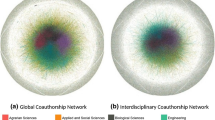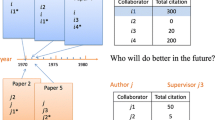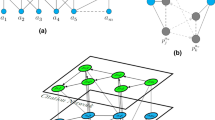Abstract
Scholarly publications reify fruitful collaborations between co-authors. A branch of research in the science studies focuses on analyzing the co-authorship networks of established scientists. Such studies tell us about how their collaborations developed through their careers. This paper updates previous work by reporting a transversal and a longitudinal studies spanning the lifelong careers of a cohort of researchers from the DBLP bibliographic database. We mined 3,860 researchers’ publication records to study the evolution patterns of their co-authorships. Two features of co-authors were considered: (1) their expertise, and (2) the history of their partnerships with the sampled researchers. Our findings reveal the ephemeral nature of most collaborations: 70 % of the new co-authors were only one-shot partners since they did not appear to collaborate on any further publications. Overall, researchers consistently extended their co-authorships (1) by steadily enrolling beginning researchers (i.e., people who had never published before), and (2) by increasingly working with confirmed researchers with whom they already collaborated.












Similar content being viewed by others
References
Abiteboul, S., Alstrup, S., Kaplan, H., Milo, T., & Rauhe, T. (2006). Compact labeling scheme for ancestor queries. SIAM Journal on Computing, 35(6), 1295–1309. doi:10.1137/s0097539703437211.
Abiteboul, S., & Bonner, A. (1991). Objects and views. SIGMOD Record, 20(2), 238–247. doi:10.1145/119995.115830.
Abiteboul, S., Gawlick, D., Gray, J., Haas, L., Halevy, A., Hellerstein, J., et al. (2005). The Lowell database research self-assessment. Communications of the ACM, 48(5), 111–118. doi:10.1145/1060710.1060718.
Abiteboul, S., Hull, R., & Vianu, V. (2005). In memory of Seymour Ginsburg 1928–2004. SIGMOD Record, 34(1), 5–12. doi:10.1145/1058150.1058152.
Abramo, G., D’Angelo, C. A., & Di Costa, F. (2009). Research collaboration and productivity: Is there correlation? Higher Education, 57(2), 155–171. doi:10.1007/s10734-008-9139-z.
Barabási, A. L., Jeong, H., Néda, Z., Ravasz, E., Schubert, A., & Vicsek, T. (2002). Evolution of the social network of scientific collaborations. Physica A: Statistical Mechanics and its Applications, 311(3–4), 590–614. doi:10.1016/S0378-4371(02)00736-7.
Beaver, D., & Rosen, R. (1978). Studies in scientific collaboration. Scientometrics, 1(1), 65–84. doi:10.1007/BF02016840.
Braun, T., Glänzel, W., & Schubert, A. (2001). Publication and cooperation patterns of the authors of neuroscience journals. Scientometrics, 50(3), 499–510. doi:10.1023/A:1012774206340.
Cabanac, G. (2012). Shaping the landscape of research in information systems from the perspective of editorial boards: A scientometric study of 77 leading journals. Journal of the American Society for Information Science and Technology, 63(5), 977–996. doi:10.1002/asi.22609.
Cabanac, G. (2013). Experimenting with the partnership ability φ-index on a million computer scientists. Scientometrics, 96(1), 1–9. doi:10.1007/s11192-012-0862-y.
Cavero, J. M., Vela, B., & Cáceres, P. (2014). Computer science research: More production, less productivity. Scientometrics, 98(3), 2103–2111. doi:10.1007/s11192-013-1178-2.
Chen, J., & Konstan, J. A. (2010). Conference paper selectivity and impact. Communications of the ACM, 53(6), 79–83. doi:10.1145/1743546.1743569.
Cheng, M. Y., Hen, K. W., Tan, H. P., & Fok, K. F. (2013). Patterns of co-authorship and research collaboration in Malaysia. Aslib Proceedings, 65(6), 659–674. doi:10.1108/AP-12-2012-0094.
Cole, J. R., & Zuckerman, H. (1984). The productivity puzzle: Persistence and change in patterns of publication of men and women scientists. In M. W. Steinkempt & M. L. Maehr (Eds.), Advances in motivation and achievement (pp. 217–258). Greenwich, Conn.: JAI Press.
Cole, S. (1979). Age and scientific performance. American Journal of Sociology, 84(4), 958–977.
Costas, R., van Leeuwen, T. N., & Bordons, M. (2010). A bibliometric classificatory approach for the study and assessment of research performance at the individual level: The effects of age on productivity and impact. Journal of the American Society for Information Science and Technology, 61(8), 1564–1581. doi:10.1002/asi.21348.
Cotta, C., & Merelo, J.-J. (2006). The complex network of EC authors. SIGEVOlution, 1(2), 2–9. doi:10.1145/1147192.1147193.
Cronin, B., Shaw, D., & Barre, K. L. (2004). Visible, less visible, and invisible work: Patterns of collaboration in 20th century chemistry. Journal of the American Society for Information Science and Technology, 55(2), 160–168. doi:10.1002/asi.10353.
Deng, H., King, I., Lyu, & M. R. (2008). Formal models for expert finding on DBLP bibliography data. In: ICDM’08: Proceedings of the 8th IEEE international conference on data mining (pp. 163–172). IEEE Computer Society. doi:10.1109/ICDM.2008.29
de Souza, C. G., & Azevedo Ferreira, M. L. (2013). Researchers profile, co-authorship pattern and knowledge organization in Information Science in Brazil. Scientometrics, 95(2), 673–687. doi:10.1007/s11192-012-0882-7.
Elmacioglu, E., & Lee, D. (2005). On six degrees of separation in DBLP-DB and more. SIGMOD Record, 34(2), 33–40. doi:10.1145/1083784.1083791.
Evans, T. S., Lambiotte, R., & Panzarasa, P. (2011). Community structure and patterns of scientific collaboration in business and management. Scientometrics, 89(1), 381–396. doi:10.1007/s11192-011-0439-1.
Frenken, K., Hölzl, W., & de Vor, F. (2005). The citation impact of research collaborations: The case of European biotechnology and applied microbiology (1988–2002). Journal of Engineering and Technology Management, 22(1–2), 9–30. doi:10.1016/j.jengtecman.2004.11.002.
Freyne, J., Coyle, L., Smyth, B., & Cunningham, P. (2010). Relative status of journal and conference publications in Computer Science. Communications of the ACM, 53(11), 124–132. doi:10.1145/1839676.1839701.
Garfield, E. (1996). What is the primordial reference for the phrase ‘Publish or Perish’? The Scientist, 10(12), 11.
Genuth, J., Chompalov, I., & Shrum, W. (2000). How experiments begin: The formation of scientific collaborations. Minerva, 38(3), 311–348. doi:10.1023/A:1026573717027.
Gingras, Y., Larivière, V., Macaluso, B., & Robitaille, J.-P. (2008). The effects of aging on researchers publication and citation patterns. PLoS ONE, 3(12), e4048. doi:10.1371/journal.pone.0004048.
Glänzel, W., & Schubert, A. (2005). Analysing scientific networks through co-authorship. In H. F. Moed, W. Glänzel, & U. Schmoch (Eds.), Handbook of quantitative science and technology research (pp. 257–276). Berlin: Springer. doi:10.1007/1-4020-2755-9_12
Goodwin, T. H., & Sauer, R. D. (1995). Life cycle productivity in academic research: Evidence from cumulative publication histories of academic economists. Southern Economic Journal, 61(3), 728–743. doi:10.2307/1060993.
Hall, B. H., Mairesse, J., & Turner, L. (2007). Identifying age, cohort, and period effects in scientific research productivity: Discussion and illustration using simulated and actual data on French physicists. Economics of Innovation and New Technology, 16(2), 159–177. doi:10.1080/10438590600983010.
Horlings, E., & Gurney, T. (2013). Search strategies along the academic lifecycle. Scientometrics, 94(3), 1137–1160. doi:10.1007/s11192-012-0789-3.
Huang, J., Zhuang, Z., Li, J., Giles, C. L. (2008). Collaboration over time: Characterizing and modeling network evolution. In: WSDM’08: Proceedings of the international conference on web search and web data mining (pp. 107–116). New York, NY, USA: ACM. doi:10.1145/1341531.1341548.
Ioannidis, Y., Maier, D., Abiteboul, S., Buneman, P., Davidson, S., Fox, E., Weikum, G. (2005). Digital library information-technology infrastructures. International Journal on Digital Libraries, 5(4), 266-–274. doi: 10.1007/s00799-004-0094-8
Katz, J. S., & Martin, B. R. (1997). What is research collaboration? Research Policy, 26(1), 1–18. doi:10.1016/S0048-7333(96)00917-1.
Kossinets, G., & Watts, D. J. (2009). Origins of homophily in an evolving social network. American Journal of Sociology, 115(2), 405–450. doi:10.1086/599247.
Kyvik, S., & Olsen, T. B. (2008). Does the aging of tenured academic staff affect the research performance of universities? Scientometrics, 76(3), 439–455. doi:10.1007/s11192-007-1767-z.
Landry, R., & Amara, N. (1998). The impact of transaction costs on the institutional structuration of collaborative academic research. Research Policy, 27(9), 901–913. doi:10.1016/S0048-7333(98)00098-5.
Lee D., Goh K.-I., Kahng B., Kim D. (2010) Complete trails of coauthorship network evolution. Physical Review E 82(2):026112–1-026112-9. doi:10.1103/PhysRevE.82.026112.
Lee, S., & Bozeman, B. (2005). The impact of research collaboration on scientific productivity. Social Studies of Science, 35(5), 673–702. doi:10.1177/0306312705052359.
Levin, S. G., & Stephan, P. E. (1989). Age and research productivity of academic scientists. Research in Higher Education, 30(5), 531–549. doi:10.1007/BF00992202.
Ley, M. (2002). The DBLP computer science bibliography: Evolution, research issues, perspectives. In: Laender, A. H. F., Oliveira, A. L. (eds), SPIRE’02 : Proceedings of the 9th international conference on String Processing and Information Retrieval (Vol. 2476, pp. 1–10). Springer, Berlin. doi:10.1007/3-540-45735-6_1.
Lotka, A. J. (1926). The frequency distribution of scientific productivity. Journal of the Washington Academy of Sciences, 16(12), 317–324.
Over, R. (1982). Does research productivity decline with age? Higher Education, 11(5), 511–520. doi:10.1007/BF00194416.
Özsu, M.T., Valduriez, P., Abiteboul, S., Kemme, B., Jiménez-Péris, R., Ooi, B.C. (2011). Distributed data management in 2020? ICDE’11 Proceedings of the 27th IEEE International Conference on Data Engineering. doi:10.1109/icde.2011.5767962.
Pitoura, E., Abiteboul, S., Pfoser, D., Samaras, G., & Vazirgiannis, M. (2003). DBGlobe: A service-oriented P2P system for global computing. SIGMOD Record, 32(3), 77–82. doi:10.1145/945721.945737.
Price, D. d. S. (1976). A general theory of bibliometric and other cumulative advantage processes. Journal of the American Society for Information Science, 27(5), 292–306. doi:10.1002/asi.4630270505.
Price, D. d. S, & Gürsey, S. (1975). Studies in scientometrics I: Transience and continuance in scientific authorship. Ciência da Informação, 4(1), 27–40.
Reitz, F., Hoffmann, O. (2010). An analysis of the evolving coverage of computer science sub-fields in the DBLP digital library. In: Lalmas, M., Jose, J., Rauber, A., Sebastiani, F., Frommholz, I. (eds.), ECDL’10: Proceedings of the 14th European conference on research and advanced technology for digital libraries (Vol. 6273, pp. 216–227). Springer, Berlin. doi:10.1007/978-3-642-15464-5_23.
Reitz, F., Hoffmann, O. (2013). Learning from the past: An analysis of person name corrections in the DBLP collection and social network properties of affected entities. In: Özyer T, Rokne J, Wagner G, Reuser A H (eds) The Influence of Technology on Social Network Analysis and Mining (Vol. 6, pp. 427–453). Springer, Berlin. doi: 10.1007/978-3-7091-1346-2_19
Reuther, P., Walter, B., Ley, M., Weber, A., Klink, S. (2006). Managing the quality of person names in DBLP. In: Gonzalo, J., Thanos, C., Verdejo, M. F., Carrasco, R. C. (eds.), ECDL’06: Proceedings of the 10th European conference on research and advanced technology for digital libraries (Vol. 4172, pp. 508–511). Springer, Berlin. doi:10.1007/11863878_55.
Schubert, A. (2012). A Hirsch-type index of co-author partnership ability. Scientometrics, 91(1), 303–308. doi:10.1007/s11192-011-0559-7.
Schubert, A., & Glänzel, W. (1991). Publication dynamics: Models and indicators. Scientometrics, 20(1), 317–331. doi:10.1007/BF02018161.
Snodgrass, R. T., Abiteboul, S., Cluet, S., Franklin, M. J., Lohman, G. M., Lomet, D. B., et al. (1999). Reminiscences on influential papers. SIGMOD Record, 28(1), 110–114.
Solomon, J. (2009). Programmers, professors, and parasites: Credit and co-authorship in Computer Science. Science and Engineering Ethics, 15(4), 467–489. doi:10.1007/s11948-009-9119-4.
Stroebe, W. (2010). The graying of academia: Will it reduce scientific productivity? American Psychologist, 65(7), 660–673. doi:10.1037/a0021086.
Stvilia, B., Hinnant, C. C., Schindler, K., Worrall, A., Burnett, G., Burnett, K., Kazmer, M. M., Marty, P. F. (2011). Composition of scientific teams and publication productivity at a national science lab. Journal of the American Society for Information Science and Technology, 62(2), 270-283. doi:10.1002/asi.21464.
Sugimoto, C. R., & Cronin, B. (2012). Biobibliometric profiling: An examination of multifaceted approaches to scholarship. Journal of the American Society for Information Science and Technology, 63(3), 450–468. doi:10.1002/asi.21695.
Velden, T., Haque, A.-U., & Lagoze, C. (2010). A new approach to analyzing patterns of collaboration in co-authorship networks: Mesoscopic analysis and interpretation. Scientometrics, 85(1), 219–242. doi:10.1007/s11192-010-0224-6.
Wallace, M. L., Larivière, V., & Gingras, Y. (2012). A small world of citations? The influence of collaboration networks on citation practices. PLoS ONE, 7(3), e33339. doi:10.1371/journal.pone.0033339.
Zhang, L., & Glänzel, W. (2012). Where demographics meets scientometrics: Towards a dynamic career analysis. Scientometrics, 91(2), 617–630. doi:10.1007/s11192-011-0590-8.
Acknowledgments
This work was supported by the French National Agency for Research (ANR-11-BSH1-0013). We acknowledge the feedback of James Hartley and András Schubert on an earlier version of this article.
Author information
Authors and Affiliations
Corresponding author
Rights and permissions
About this article
Cite this article
Cabanac, G., Hubert, G. & Milard, B. Academic careers in Computer Science: continuance and transience of lifetime co-authorships. Scientometrics 102, 135–150 (2015). https://doi.org/10.1007/s11192-014-1426-0
Received:
Published:
Issue Date:
DOI: https://doi.org/10.1007/s11192-014-1426-0




